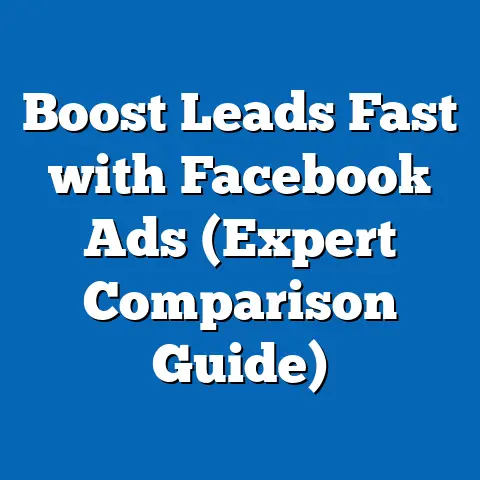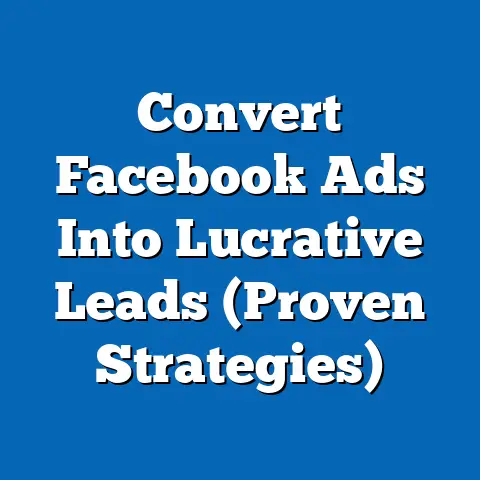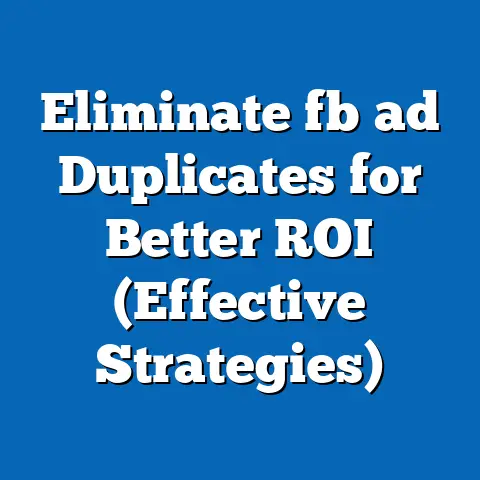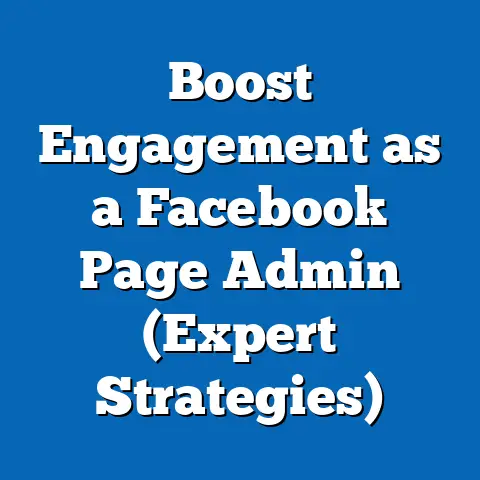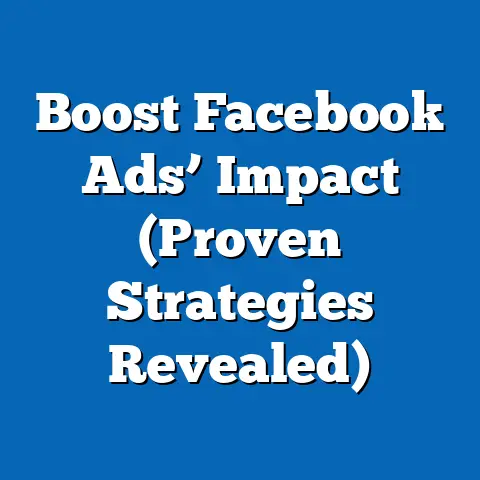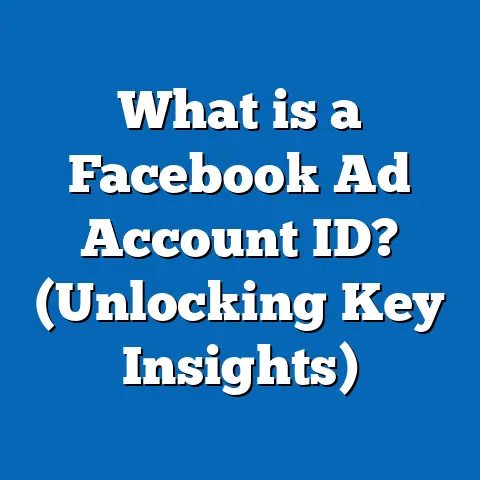Boost Case Numbers with Facebook Ads (Proven Strategies)
In the dynamic landscape of modern business, digital advertising has revolutionized how we connect with potential clients and drive growth. Among the myriad of online platforms, Facebook Ads stands out as a powerhouse, offering unparalleled targeting capabilities, a massive user base, and robust analytics tools. I’ve seen firsthand how businesses, from burgeoning startups to established enterprises, have leveraged Facebook Ads to achieve remarkable results. Today, I want to delve into how you can harness the power of Facebook Ads to specifically boost your case numbers – whether you’re a law firm seeking new clients, a healthcare provider aiming to expand your patient base, or any business that relies on a steady flow of cases.
Understanding Your Audience
One of the most crucial aspects of a successful Facebook Ads campaign is understanding your audience. It’s not enough to simply target “everyone” – you need to pinpoint the specific demographics, interests, and behaviors of your ideal clients. This is where audience segmentation comes into play.
The Power of Audience Segmentation
Audience segmentation involves dividing your potential clients into smaller, more defined groups based on shared characteristics. By segmenting your audience, you can tailor your ad content and targeting to resonate with each group, leading to higher engagement and conversion rates.
Facebook’s Targeting Options: A Treasure Trove of Data
Facebook offers a wealth of targeting options, allowing you to reach your ideal clients with laser-like precision. These options include:
- Demographics: Target users based on age, gender, location, education, relationship status, and more.
- Interests: Reach users who have expressed an interest in specific topics, hobbies, or activities. This is based on the pages they like, the groups they join, and the content they engage with.
- Behaviors: Target users based on their online behavior, such as purchase history, device usage, travel habits, and more.
- Custom Audiences: Upload your own customer data (email lists, phone numbers) to create custom audiences and target your existing clients or lookalikes.
- Lookalike Audiences: Expand your reach by creating lookalike audiences based on your existing customers. Facebook will identify users who share similar characteristics and behaviors with your current clients.
Creating Buyer Personas: Getting Inside Your Ideal Client’s Head
To truly understand your audience, I recommend creating detailed buyer personas. A buyer persona is a fictional representation of your ideal client, based on research and data about your existing customers.
When creating a buyer persona, consider the following:
- Demographics: Age, gender, location, income, education, occupation.
- Psychographics: Values, interests, lifestyle, personality.
- Goals and Challenges: What are they trying to achieve? What obstacles are they facing?
- Pain Points: What are their biggest frustrations and concerns?
- Information Sources: Where do they go for information and advice?
- Facebook Usage: How do they use Facebook? What types of content do they engage with?
By developing detailed buyer personas, you can gain a deeper understanding of your ideal clients and tailor your ad content and targeting to meet their specific needs and interests.
Real-Life Example:
I once worked with a personal injury law firm that was struggling to generate leads through Facebook Ads. Initially, they were targeting a broad audience of adults aged 25-65 in their local area. However, their ads weren’t resonating, and they were spending a lot of money with little to show for it.
After conducting thorough audience research and creating detailed buyer personas, we discovered that their ideal client was typically a middle-aged individual who had been injured in a car accident and was seeking legal representation to help them navigate the insurance claim process.
Based on this insight, we refined their targeting to focus on users who had expressed an interest in car accidents, personal injury law, and insurance claims. We also created ad content that addressed their specific pain points and concerns, such as the complexities of the legal system and the fear of being taken advantage of by insurance companies.
As a result of these changes, the law firm saw a significant increase in leads and case numbers. Their cost per lead decreased by 50%, and their conversion rate doubled. This demonstrates the power of understanding your audience and tailoring your ad content and targeting to meet their specific needs.
Key Takeaway:
Understanding your audience is the foundation of a successful Facebook Ads campaign. By segmenting your audience, utilizing Facebook’s targeting options, and creating detailed buyer personas, you can ensure that your ads are reaching the right people with the right message.
Next Steps:
- Conduct thorough audience research to identify the demographics, interests, and behaviors of your ideal clients.
- Create detailed buyer personas to gain a deeper understanding of your target audience.
- Refine your Facebook Ads targeting to focus on your ideal clients.
Crafting Compelling Ad Content
Once you’ve identified your target audience, the next step is to create compelling ad content that grabs their attention and persuades them to take action. This involves crafting engaging headlines, persuasive copy, and strong calls to action.
The Elements of High-Performing Ad Content
- Engaging Headlines: Your headline is the first thing people will see, so it needs to be attention-grabbing and relevant to your target audience. Use strong keywords, ask a question, or make a bold statement.
- Persuasive Copy: Your ad copy should clearly communicate the benefits of your product or service and explain why your target audience should choose you over the competition. Focus on solving their problems and addressing their pain points.
- Strong Calls to Action: Tell people exactly what you want them to do. Use clear and concise calls to action, such as “Learn More,” “Get a Free Quote,” or “Contact Us Today.”
The Importance of Visual Content
Visual content is essential for capturing attention and conveying your message effectively. Use high-quality images or videos that are relevant to your target audience and showcase the benefits of your product or service.
When choosing visuals, consider the following:
- Relevance: Make sure your visuals are relevant to your ad copy and target audience.
- Quality: Use high-resolution images and videos that are visually appealing.
- Branding: Incorporate your brand colors and logo into your visuals to maintain consistency.
- Emotion: Use visuals that evoke emotion and connect with your target audience on a personal level.
Conveying Your Unique Value Proposition
Your unique value proposition (UVP) is what sets you apart from the competition. It’s the reason why your target audience should choose you over everyone else.
When crafting your ad content, make sure to clearly communicate your UVP and highlight the benefits that your target audience will receive. Focus on what makes you different and why you’re the best choice for their needs.
Examples of Successful Ad Campaigns:
I’ve seen countless ad campaigns that have effectively used compelling content to boost case numbers. Here are a few examples:
- A law firm running ads with the headline “Injured in a Car Accident? We Can Help.” The ad copy highlights their experience in personal injury law and their commitment to helping clients get the compensation they deserve. The call to action is “Get a Free Consultation.”
- A healthcare provider running video ads showcasing patient testimonials. The testimonials highlight the positive experiences of patients who have received treatment at their facility. The call to action is “Schedule an Appointment Today.”
- A business running carousel ads showcasing different products or services. Each carousel card highlights the benefits of a specific product or service and includes a call to action to learn more.
Key Takeaway:
Compelling ad content is essential for capturing attention, conveying your message effectively, and persuading your target audience to take action. Focus on crafting engaging headlines, persuasive copy, and strong calls to action. Use high-quality visuals that are relevant to your target audience and showcase the benefits of your product or service.
Next Steps:
- Brainstorm engaging headlines and persuasive ad copy that resonates with your target audience.
- Choose high-quality visuals that are relevant to your ad content and target audience.
- Incorporate strong calls to action that tell people exactly what you want them to do.
Utilizing Facebook Ad Formats
Facebook offers a variety of ad formats, each with its own unique benefits and capabilities. Choosing the right ad format can significantly impact the success of your campaign.
Different Ad Formats and Their Benefits
- Image Ads: Simple and effective for showcasing a single product or service.
- Video Ads: Engaging and attention-grabbing for telling a story or demonstrating a product.
- Carousel Ads: Allow you to showcase multiple products or services in a single ad.
- Collection Ads: Showcase a catalog of products and allow users to browse and purchase directly from the ad.
- Instant Experience Ads: Full-screen, mobile-optimized experiences that load instantly and provide an immersive brand experience.
- Lead Ads: Allow you to collect leads directly from Facebook without sending users to your website.
- Messenger Ads: Allow you to reach users directly in their Facebook Messenger inbox.
Choosing the Right Ad Format
The best ad format for your campaign will depend on your objectives, target audience, and budget.
- If you’re looking to generate leads, Lead Ads may be the best option.
- If you want to showcase multiple products or services, Carousel Ads or Collection Ads may be a good choice.
- If you want to tell a story or demonstrate a product, Video Ads may be the most effective.
Combining Ad Formats for a Cohesive Strategy
I often recommend combining different ad formats for a cohesive advertising strategy. For example, you could use a Video Ad to introduce your brand and then use Carousel Ads to showcase your products or services.
Statistics and Case Studies:
I’ve seen numerous statistics and case studies demonstrating the increased engagement and conversions from specific ad formats. For example, video ads tend to have higher engagement rates than image ads, and carousel ads tend to generate more clicks than single-image ads.
Key Takeaway:
Facebook offers a variety of ad formats, each with its own unique benefits and capabilities. Choose the right ad format based on your campaign objectives, target audience, and budget. Consider combining different ad formats for a cohesive advertising strategy.
Next Steps:
- Research the different ad formats available on Facebook and their specific benefits.
- Choose the ad format that is most appropriate for your campaign objectives and target audience.
- Experiment with different ad formats to see what works best for your business.
Implementing Retargeting Strategies
Retargeting is a powerful strategy for re-engaging potential clients who have previously interacted with your content or website. It involves showing ads to people who have visited your website, watched your videos, or engaged with your Facebook page.
What is Retargeting and Why is it Important?
Retargeting allows you to stay top-of-mind with potential clients and encourage them to take action. It’s a highly effective way to increase conversions and boost case numbers.
Setting Up Retargeting Campaigns on Facebook
To set up retargeting campaigns on Facebook, you’ll need to install the Facebook Pixel on your website. The Facebook Pixel is a piece of code that tracks website visitors and their actions.
Once you’ve installed the Facebook Pixel, you can create custom audiences based on website visitors, video viewers, and other engagement metrics.
Creating Effective Retargeting Ads
Retargeting ads should be tailored to the specific audience you’re targeting. For example, you could show ads to website visitors who viewed a specific product page or watched a particular video.
Your retargeting ads should also include a strong call to action that encourages people to take the next step, such as “Learn More,” “Get a Free Quote,” or “Contact Us Today.”
Examples of Successful Retargeting Campaigns:
I’ve seen many businesses successfully use retargeting to boost their case numbers. Here are a few examples:
- A law firm running retargeting ads to website visitors who viewed their personal injury page. The ads highlight their experience in personal injury law and offer a free consultation.
- A healthcare provider running retargeting ads to users who watched their video about a specific treatment. The ads provide more information about the treatment and encourage viewers to schedule an appointment.
- A business running retargeting ads to users who added items to their shopping cart but didn’t complete the purchase. The ads offer a discount or free shipping to encourage them to complete the purchase.
Key Takeaway:
Retargeting is a powerful strategy for re-engaging potential clients and encouraging them to take action. Set up retargeting campaigns on Facebook and create effective retargeting ads that are tailored to the specific audience you’re targeting.
Next Steps:
- Install the Facebook Pixel on your website.
- Create custom audiences based on website visitors, video viewers, and other engagement metrics.
- Create effective retargeting ads that are tailored to the specific audience you’re targeting.
Analyzing and Optimizing Campaign Performance
The final step in boosting your case numbers with Facebook Ads is to analyze and optimize your campaign performance. This involves tracking key performance indicators (KPIs) and making data-driven decisions to improve your results.
The Importance of Analytics
Analytics are essential for understanding the performance of your Facebook Ad campaigns. By tracking KPIs, you can identify what’s working and what’s not and make adjustments to improve your results.
Key Performance Indicators (KPIs) to Monitor
- Click-Through Rate (CTR): The percentage of people who see your ad and click on it.
- Conversion Rate: The percentage of people who click on your ad and complete a desired action, such as filling out a form or making a purchase.
- Cost Per Acquisition (CPA): The cost of acquiring a new client or customer.
- Return on Ad Spend (ROAS): The amount of revenue generated for every dollar spent on advertising.
- Reach: The number of unique people who saw your ad.
- Frequency: The average number of times each person saw your ad.
Interpreting Data and Making Data-Driven Decisions
Once you’ve collected data on your campaign performance, you need to interpret it and make data-driven decisions to optimize your results.
For example, if your CTR is low, you may need to improve your ad copy or visuals. If your conversion rate is low, you may need to improve your landing page or offer a more compelling incentive. If your CPA is high, you may need to refine your targeting or adjust your bidding strategy.
Case Study:
I once worked with a business that was running Facebook Ads to generate leads. Initially, their campaign was performing poorly, and they were spending a lot of money with little to show for it.
After analyzing their campaign performance, we discovered that their CTR was low, and their CPA was high. We also noticed that their ads were being shown to a broad audience, including people who were not interested in their product or service.
Based on this insight, we refined their targeting to focus on a more specific audience, improved their ad copy and visuals, and adjusted their bidding strategy.
As a result of these changes, their CTR increased, their CPA decreased, and their lead generation improved significantly. This demonstrates the power of analyzing and optimizing ad performance to achieve better results.
Key Takeaway:
Analyzing and optimizing campaign performance is essential for maximizing your ROI and boosting your case numbers with Facebook Ads. Track key performance indicators and make data-driven decisions to improve your results.
Next Steps:
- Track key performance indicators for your Facebook Ad campaigns.
- Analyze your campaign performance to identify what’s working and what’s not.
- Make data-driven decisions to optimize your results.
Conclusion
In conclusion, Facebook Ads provide an unprecedented opportunity for businesses to connect with potential clients and boost their case numbers. By understanding your audience, crafting compelling ad content, utilizing the right ad formats, implementing retargeting strategies, and analyzing your campaign performance, you can unlock the full potential of Facebook advertising.
Innovation in advertising, especially through platforms like Facebook, provides businesses with unprecedented opportunities to connect with potential clients. Don’t be afraid to experiment, test new strategies, and continuously optimize your campaigns for better results.
I encourage you to take the next step in utilizing Facebook Ads to enhance your business outcomes and case numbers. Start by implementing the strategies discussed in this article and tracking your results. With a strategic approach and a commitment to continuous improvement, you can achieve remarkable success with Facebook Ads. Now, go out there and start boosting those case numbers!

